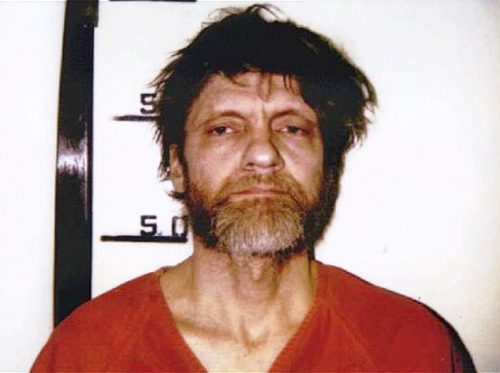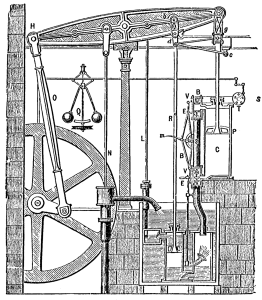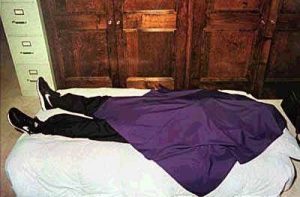Theodore “Ted” Kaczynski, nicknamed the “Unabomber,” killed and injured several people from 1978 to 1995 using mail bombs. Many experts on terrorism have difficulty in establishing whether to consider Ted a terrorist. Some believe he is simply a murderer, while others say that because of his political agenda and his decision to go after certain kinds of people, like science professors and big businessmen, that he should indeed be classified as a terrorist.1
Years before his bombing spree, in 1958, Kaczynski had been a student at Harvard University. The most astounding part is that he was only sixteen years old when he attended his first year as a freshman in college. As a child, Ted had been deemed a gifted student by his teachers. He reportedly had an IQ of 157 at the age of ten. He was allowed to skip sixth grade and work with older students, but he did not like that at all. In his journal, Ted described working with older students as considerably difficult, and he was regularly taunted by them. He never seemed to fit in. During high school, his struggle to be social continued, and he felt isolated from the rest of the students. Despite all of these problems, he still excelled academically and was allowed to skip the eleventh grade. He did have a moment of social fame which came when he made a pipe bomb in one of his science classes, but that moment of fame soon died away and he was alone again.2
During his time at Harvard, Ted continued to have extreme success academically, but still failed to be a part of the college’s social life. He lived in a single room, and some of his classmates recalled the room as messy, and that Kaczynski hardly had any interaction with any of his peers. At Harvard, he joined a study to determine the effects of extreme stress on the human psyche. The study had participants undergo extreme interrogations and personal belittlement over their beliefs and ideals. These interrogations upset Kaczynski, and he began to feel a disdain towards society and authority. According to Alston Chase, a Kaczynski researcher, Ted began to develop a theory to explain his anger and unhappiness. Chase said that, in Ted’s eyes, science and technology were destroying liberty and nature. The “system,” which included Harvard, sought to transform men into automatons to serve the machine by using techniques of behavior modification like propaganda and advertising. Unknowingly, during his undergraduate career, Ted was well on his way to becoming the Unabomber. He completed his undergraduate degree in mathematics in 1962, and went on to graduate school at the University of Michigan. He earned his master’s and Ph.D. in mathematics, and professors often described him as ambitious and talented.3
At that time, the University of California at Berkeley was considered the center of the counterculture movement, and that is where Ted decided to begin his career as a professor. He was uninterested in political activism, and failed, yet again, to become involved with those around him. He didn’t really have the talent to be a teacher and was very unpopular with students. So in January of 1969, he decided to resign his position at the end of the term. He also intended to give up mathematics altogether. His professional and social life began to spiral down after the decisions he had made.4

After his resignation, Kaczynski returned to Illinois, which was where he was born, and lived in a house owned by his parents. He was unemployed, and worked random jobs to get money, as well as borrowing money from his parents. Kaczynski was living as a hermit in the 1970s, and had little interaction with people as he began to sink deeper into his social isolation and anger. He directed all of that anger towards technology and its advancements in society. He began to write about the evils that came with technology and its control over individuals.5 During his time as a hermit, Ted decided to move to Montana where his brother lived. They split the cost of an open piece of land near Lincoln, Montana, and he began to construct a rudimentary cabin that measured 10 by 12 feet and lacked running water, electricity, and heat. Some of his neighbors described him as a quiet man who rode his homemade bicycle and spent a lot of time at the library. He enjoyed reading, and he acquired a substantial collection of volumes that filled his little home. As the decade progressed, he became more and more isolated from society. He returned to Illinois in 1978 and worked at a foam rubber factory where his brother was a supervisor. He was fired by his brother just a few weeks later, after posting insulting limericks around the factory because he had been rejected by a female plant manager. Many believe that this event was the tipping point that began his bombing campaign.6
Ted Kaczynski’s lengthy bombing campaign began on May 25, 1978, when he sent out his first bomb to Northwestern University. The box containing the bomb had a return address with the name of Professor Buckley Crist. The professor was suspicious of receiving a package that she never sent out and asked a campus officer to open it. The bomb detonated and caused the officer minor injuries. Ted then continued his campaign by attempting to bomb an airplane in November of 1979. The bomb detonated in the cargo hold and forced the place to land immediately. This attack sparked the start of a major investigation codenamed “Unabom” because of the university-based targets and the attack on a United Airlines executive.7

Throughout the span of seventeen years, the Unabomber seriously injured more than twenty-two people and killed three. One of the most notable deadly bombings was that of Gilbert Murray, a California timber-industry lobbyist. The package arrived on Monday, April 20. The first person to come in contact with the shoebox-size package was the receptionist who had trouble opening the package and carried it to her boss’ desk. At this point in Kaczynski’s bombing campaign, he had developed much more powerful and deadlier bombs that his previous ones. As Murray started to unwrap the package, it blew up in his hands. The blast killed Murray, forty-seven years old, and was so powerful it knocked two doors off their hinges and blew gashes into the ceiling panels. It was also loud enough that people heard it for blocks around. This startled and scared many people because the Oklahoma City bombing had occurred only five days earlier.8 It turns out that the bomb was never intended to kill Gilbert Murray but instead his predecessor, William Dennison. Dennison was the chief lobbyist for the forest-products trade group from 1980 to 1994 and a highly visible figure in a number of environmental issues. He was replaced by Murray who was killed by a package addressed to Dennison. At that time, William Dennison was seen as the No. 1 person in the timber industry because he was a prominent voice in the Pacific Northwest during the “the timber wars,” which involved environmentalists going up against ranchers, loggers, and the timber industry. Dennison was a key figure in the timber industry and many, including Ted, saw him as a threat to the environment, which could have been a reason why the Unabomber chose him, specifically.9

Around the time of the attack that killed Gilbert Murray, the Unabomber sent a letter to different newspapers, including the New York Times, that offered to stop his bombing spree if they published a manuscript titled “Industrial Society and Its Future,” which would later be known as the “Unabomber Manifesto.” If they did not comply, he threatened that the Freedom Club—”FC” was engraved on all his bombs—would ramp up their terrorist campaign. The manifesto ended up getting published by the Washington Post with help from Time Magazine on September 19, 1995. David Kaczynski, Ted’s brother, read the manifesto and recognized his brother’s writing style from reading unfinished copies that Ted had in his cabin. David contacted the authorities and Ted Kaczynski was arrested in April of 1996 in Montana. In his cabin, they found more than enough evidence, which included bomb-making supplies and early versions of the manifesto, to prove Kaczynski guilty. Two months later, he was charged with several criminal counts relating to the production and distribution of mail bombs. He resisted his lawyers’ efforts of declaring him insane and ended up not being able to represent himself in court. He agreed to a plea deal in 1998 to avoid going to trial. He pled guilty and was sentenced to life in prison without parole, and is still currently serving his sentence.10
- The Greenhaven Encyclopedia of Terrorism, 2007, s.v. “Unabomber, the (1942),” by Patricia D. Netzley. ↵
- Salem Press Encyclopedia of Science, 2013, s.v. “Unabomber case,” by Brion Sever. ↵
- Encyclopedia of World Biography, 2013, s.v. “Ted Kaczynski.” ↵
- Encyclopedia of World Biography, 2013, s.v. “Ted Kaczynski.” ↵
- Salem Press Encyclopedia of Science, 2013, s.v. “Unabomber case,” by Brion Sever. ↵
- Encyclopedia of World Biography, 2013, s.v. “Ted Kaczynski.” ↵
- Salem Press Encyclopedia of Science, 2014, s.v. “Unabomber” by Steve Hewitt. ↵
- Michael Lemonick and Jordan Bontante, “The bomb is in the mail,” Time, May 8, 1995, http://content.time.com/time/magazine/article/0,9171,982900,00.html. ↵
- Kenneth B. Noble, “Bombing in Sacramento: The Investigation; Bomb Meant for Predecessor Of Victim, Officials Say,” The New York Times, April 26, 1995, https://www.nytimes.com/1995/04/26/us/bombing-sacramento-investigation-bomb-meant-for-predecessor-victim-officials-say.html. ↵
- Encyclopedia of World Biography, 2013, s.v. “Ted Kaczynski.” ↵



111 comments
Pamela Callahan
I don’t understand what would drive people to make such rash, dramatic decisions. I know that people can get stressed or feel bad because they are being picked on, but that doesn’t justify their violent actions. For someone to intentionally send bombs to specific people in order to have them killed is a scary and horrible thing to do and I think that people need to think through their actions more clearly before doing something that they might regret.
Enrique Segovia
Thanks to this article, now I know why he was called the “Unabomber”. I find it odd why he chose his victims, and how it was really hard for his killing spree to end after seventeen years. The Unabomber had social hardships, and most likely, his desire to attack people arose from this lack of social skills ever since he was a child. I am impressed how Ted was actually a genius and had the most excellent academic distinctions in school and at college. Even though he was younger than his fellow students, he outsmarted them all. Yet, his social skills were poor, and this would prove to be detrimental in the future.
Megan Copeland
I had prior knowledge about the Unabomber before reading this article, but not a ton of details. I think this article gave a lot of important background information about Ted Kaczinsky that explained why he could have done these terrible things. One thing I find so crazy is that he attended Harvard University at the age of only 16. It is clear that he was a very intelligent person, which makes a lot of sense because it takes a very intelligent person to be able to pull off crimes of that magnitude.
Avery Looney
I am familiar with the Unabomber, but I never knew his background. Its obvious that the person who is capable of this had to be extremely intelligent, but I never thought that Ted Kaczynski would be a freshman at Harvard University at the age of sixteen. This article does a great job of telling the story of Ted Kaczynski and his isolation throughout his life and his ultimate breaking point.
Janelle Larios
I have never heard of this person or the bombings. It seems scary to receive a letter or package and it blowing up in your face. I thought it was interesting knowing that he had such a High IQ and was very smart through out his life, that his intelligence didn’t diminish as he grew older. It makes you wonder what could he could have done if he was more social or accepted in society and had those functions. Even so he turned out this way and that’s the scary thing, that he was influenced by his experiences and thought hurting and or killing people would help his cause.
Kathyleen Lauriano
I have never heard about the Unabomber until I read this article. For him to be someone so intelligent and advanced for his age you would never guess that he would become a murderer. Its interesting that it was all based on technology as to why he was angry. For his own brother to turn him in was very courageous. Im glad he was caught and serving his time for what he did.
Bruno Montes de Oca
The Unabomber is in my mind no doubt a terrorist. Actions like his are done to instill fear into people’s minds. He had a political agenda and was targeting big figures in society. He once again tried to instill fear into people when he threatened to ramp up his bombing unless his manifesto was published. In my mind he is no doubt a terrorist. It is just crazy to me how such a brilliant mind can turn to such waste. He was truly a genius that was just not in the right headspace.
Jasmine Rocha
I really liked how the article highlighted leading up to the bombings and how the Unabomber might have come into the world or the idea of him. It is interesting knowing how he had so much potential because he was seen as brilliant but because of how socially unattached he was from the world that brilliance was not a good thing. I wish there was more information on the bombs and how the creation of them showed how brilliant this man really was.
Alexandria Zapata
This article was well written and very good details. Its crazy to think that he was was a 16 year old at Harvard, and it looked like he had a pretty normal childhood academically, despite never fitting in. It’s also interesting to see how he went from going to Harvard, and being a professor, to going back home, and being unemployment and having nothing. It was then that people believed that the tipping point was when a female worker rejected him. He killed so many people and was only caught because his brother recognized his handwriting.
Jose Fernandez
This is the first time I hear about The Unabomber. I think it’s interesting because it isn’t common for a terrorist to have the education and resources this person had. It is sad to hear that someone who could have done so much good for the world ended up sending bombs through the mail. I am very glad they caught him and that he is paying for what he did. I also found it interesting that his own brother was the key to his capture.